Analyzing Nike: A Report on Sports Organization Theory and Strategies
VerifiedAdded on 2021/06/14
|37
|9782
|20
Report
AI Summary
This report delves into the sports industry with a focus on Nike, examining its internal policies, organizational behavior, and outsourcing strategies. It contrasts organizational theory with actual behavior within Nike, highlighting the company's resource utilization and business-level strategies. The report suggests strategic alliances, such as with PepsiCo, and business diversification through energy drink launches to enhance competitive advantage. Change management processes, internal management elements, and identified gaps are discussed, along with recommended steps and their critical analysis, concluding with an evaluation of the current approach's effectiveness in addressing global organizational challenges.
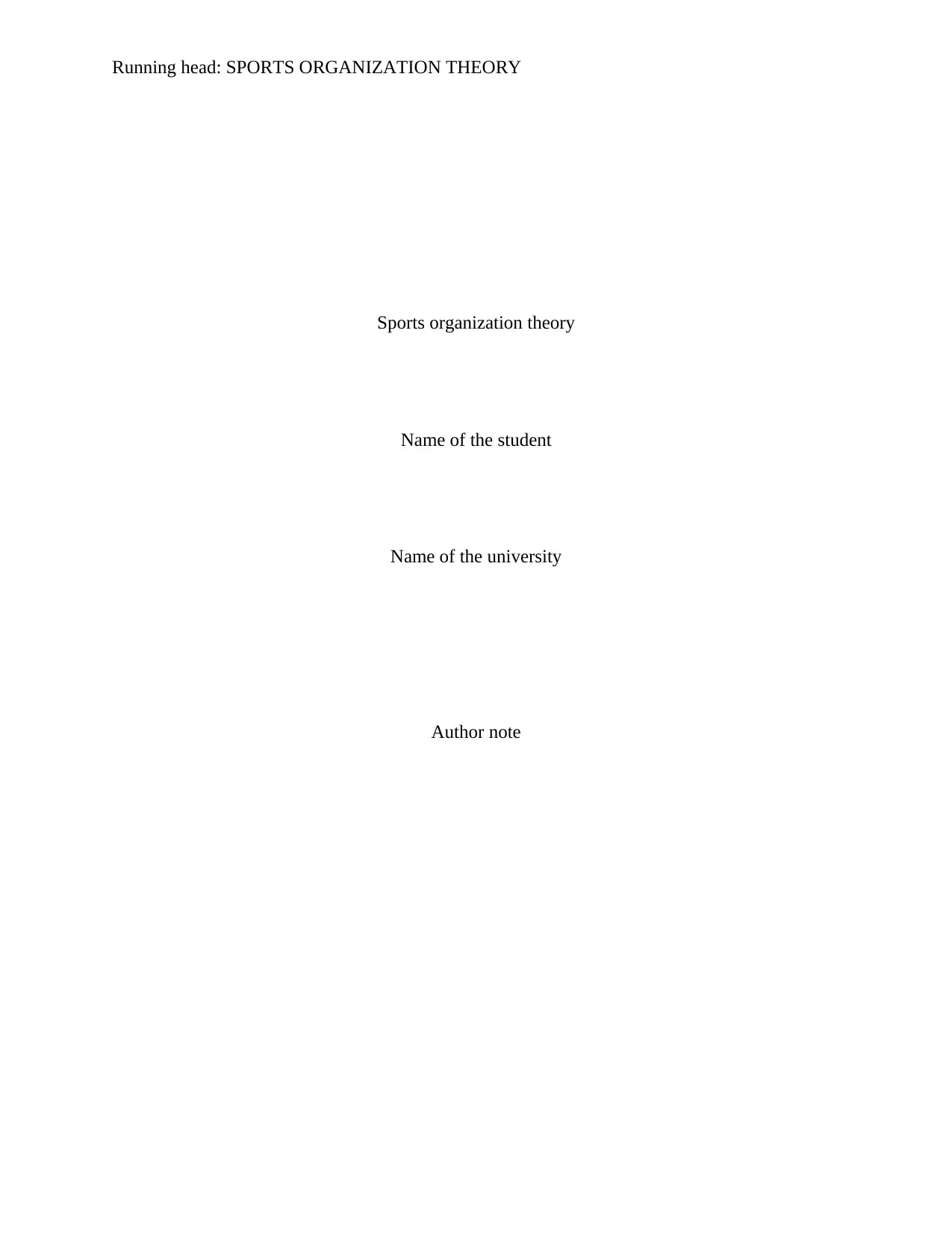
Running head: SPORTS ORGANIZATION THEORY
Sports organization theory
Name of the student
Name of the university
Author note
Sports organization theory
Name of the student
Name of the university
Author note
Paraphrase This Document
Need a fresh take? Get an instant paraphrase of this document with our AI Paraphraser
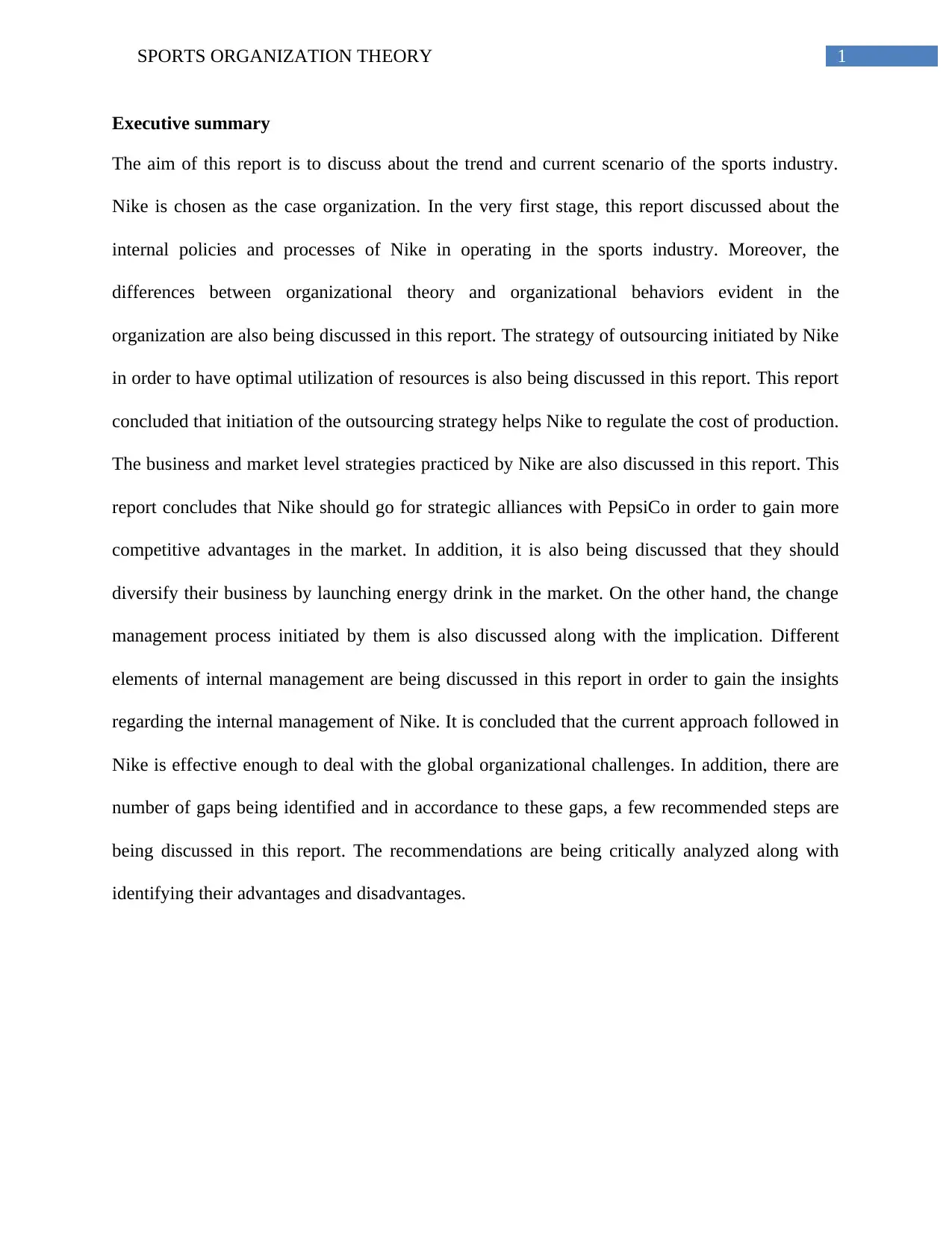
1SPORTS ORGANIZATION THEORY
Executive summary
The aim of this report is to discuss about the trend and current scenario of the sports industry.
Nike is chosen as the case organization. In the very first stage, this report discussed about the
internal policies and processes of Nike in operating in the sports industry. Moreover, the
differences between organizational theory and organizational behaviors evident in the
organization are also being discussed in this report. The strategy of outsourcing initiated by Nike
in order to have optimal utilization of resources is also being discussed in this report. This report
concluded that initiation of the outsourcing strategy helps Nike to regulate the cost of production.
The business and market level strategies practiced by Nike are also discussed in this report. This
report concludes that Nike should go for strategic alliances with PepsiCo in order to gain more
competitive advantages in the market. In addition, it is also being discussed that they should
diversify their business by launching energy drink in the market. On the other hand, the change
management process initiated by them is also discussed along with the implication. Different
elements of internal management are being discussed in this report in order to gain the insights
regarding the internal management of Nike. It is concluded that the current approach followed in
Nike is effective enough to deal with the global organizational challenges. In addition, there are
number of gaps being identified and in accordance to these gaps, a few recommended steps are
being discussed in this report. The recommendations are being critically analyzed along with
identifying their advantages and disadvantages.
Executive summary
The aim of this report is to discuss about the trend and current scenario of the sports industry.
Nike is chosen as the case organization. In the very first stage, this report discussed about the
internal policies and processes of Nike in operating in the sports industry. Moreover, the
differences between organizational theory and organizational behaviors evident in the
organization are also being discussed in this report. The strategy of outsourcing initiated by Nike
in order to have optimal utilization of resources is also being discussed in this report. This report
concluded that initiation of the outsourcing strategy helps Nike to regulate the cost of production.
The business and market level strategies practiced by Nike are also discussed in this report. This
report concludes that Nike should go for strategic alliances with PepsiCo in order to gain more
competitive advantages in the market. In addition, it is also being discussed that they should
diversify their business by launching energy drink in the market. On the other hand, the change
management process initiated by them is also discussed along with the implication. Different
elements of internal management are being discussed in this report in order to gain the insights
regarding the internal management of Nike. It is concluded that the current approach followed in
Nike is effective enough to deal with the global organizational challenges. In addition, there are
number of gaps being identified and in accordance to these gaps, a few recommended steps are
being discussed in this report. The recommendations are being critically analyzed along with
identifying their advantages and disadvantages.
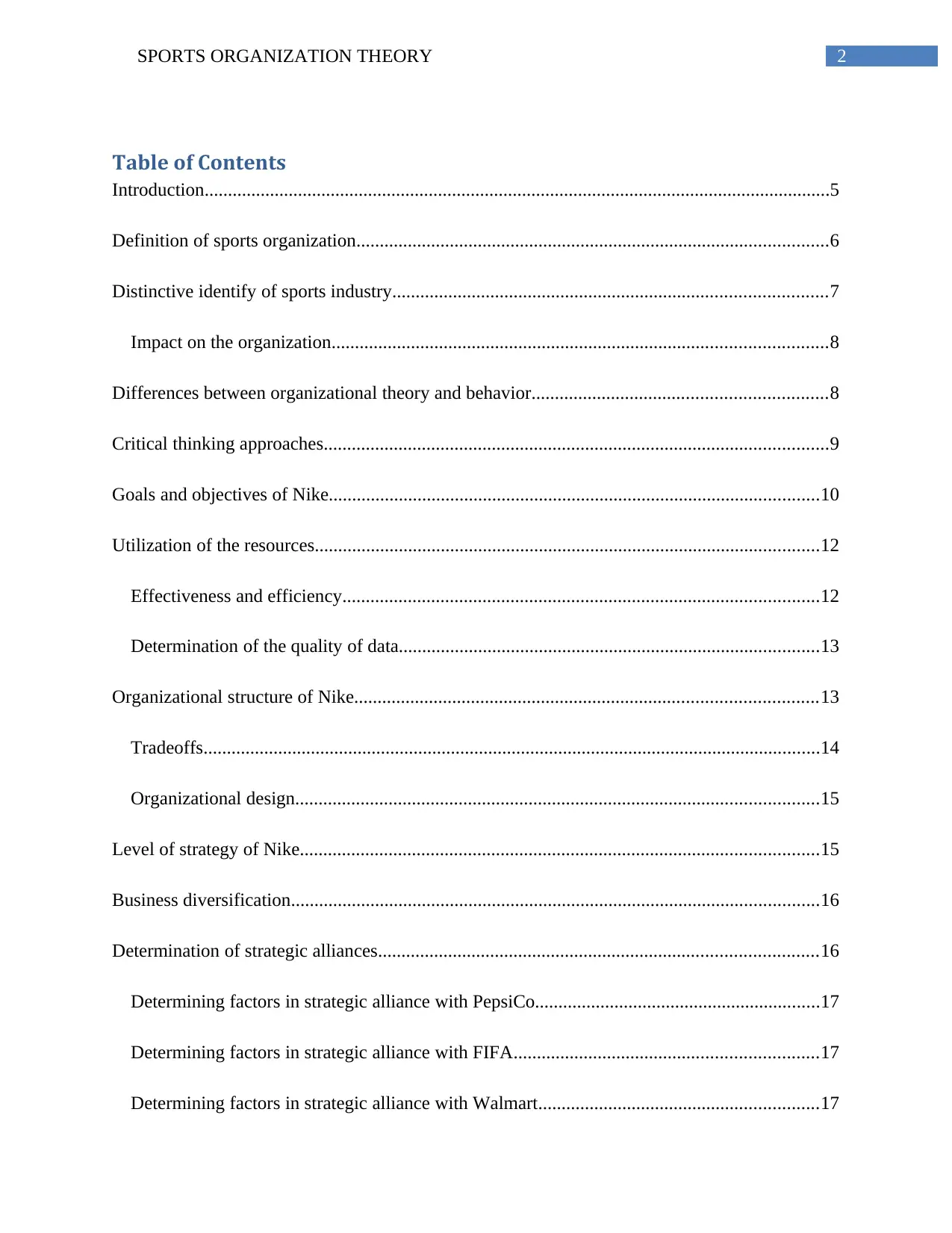
2SPORTS ORGANIZATION THEORY
Table of Contents
Introduction......................................................................................................................................5
Definition of sports organization.....................................................................................................6
Distinctive identify of sports industry.............................................................................................7
Impact on the organization..........................................................................................................8
Differences between organizational theory and behavior...............................................................8
Critical thinking approaches............................................................................................................9
Goals and objectives of Nike.........................................................................................................10
Utilization of the resources............................................................................................................12
Effectiveness and efficiency......................................................................................................12
Determination of the quality of data..........................................................................................13
Organizational structure of Nike...................................................................................................13
Tradeoffs....................................................................................................................................14
Organizational design................................................................................................................15
Level of strategy of Nike...............................................................................................................15
Business diversification.................................................................................................................16
Determination of strategic alliances..............................................................................................16
Determining factors in strategic alliance with PepsiCo.............................................................17
Determining factors in strategic alliance with FIFA.................................................................17
Determining factors in strategic alliance with Walmart............................................................17
Table of Contents
Introduction......................................................................................................................................5
Definition of sports organization.....................................................................................................6
Distinctive identify of sports industry.............................................................................................7
Impact on the organization..........................................................................................................8
Differences between organizational theory and behavior...............................................................8
Critical thinking approaches............................................................................................................9
Goals and objectives of Nike.........................................................................................................10
Utilization of the resources............................................................................................................12
Effectiveness and efficiency......................................................................................................12
Determination of the quality of data..........................................................................................13
Organizational structure of Nike...................................................................................................13
Tradeoffs....................................................................................................................................14
Organizational design................................................................................................................15
Level of strategy of Nike...............................................................................................................15
Business diversification.................................................................................................................16
Determination of strategic alliances..............................................................................................16
Determining factors in strategic alliance with PepsiCo.............................................................17
Determining factors in strategic alliance with FIFA.................................................................17
Determining factors in strategic alliance with Walmart............................................................17
⊘ This is a preview!⊘
Do you want full access?
Subscribe today to unlock all pages.

Trusted by 1+ million students worldwide
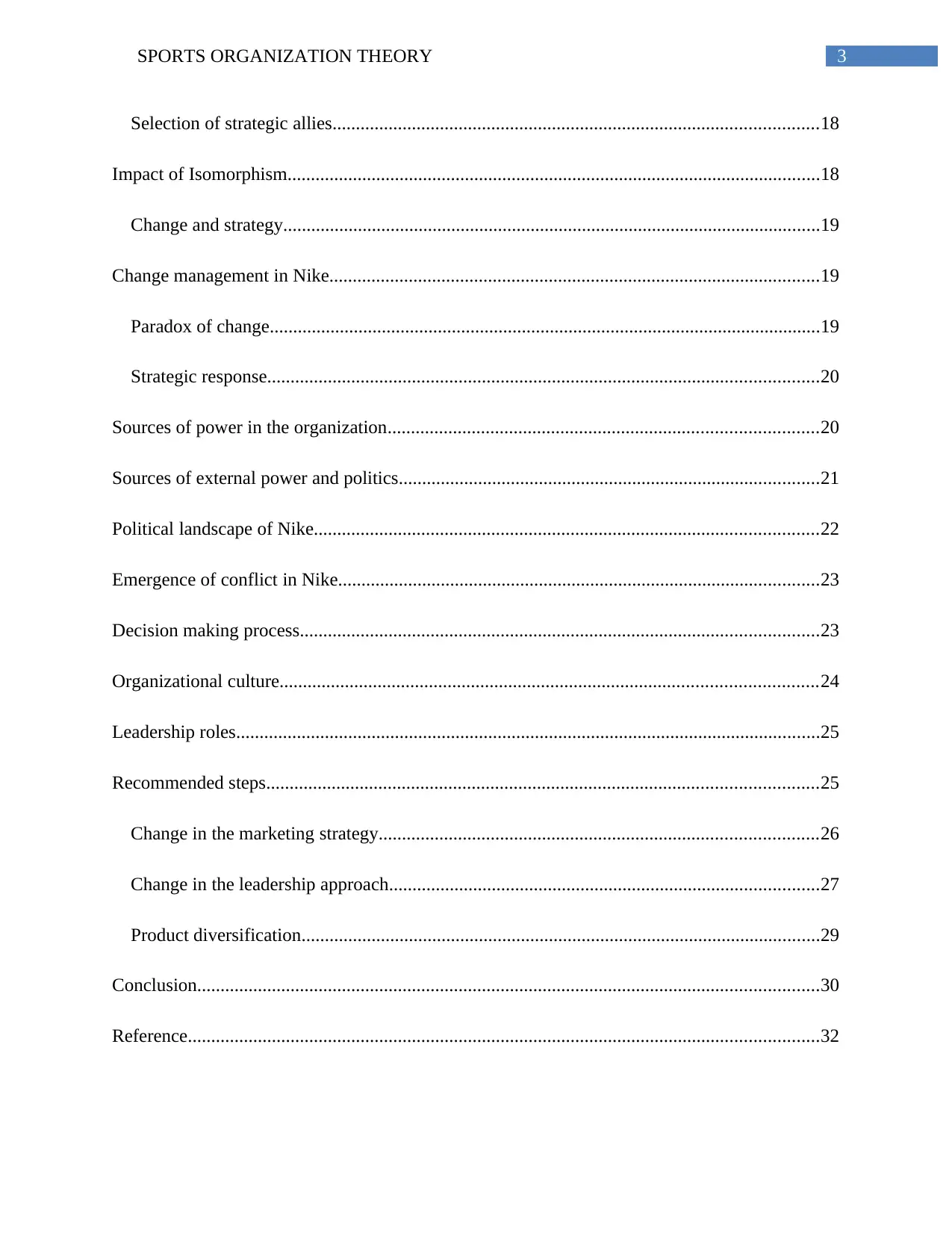
3SPORTS ORGANIZATION THEORY
Selection of strategic allies........................................................................................................18
Impact of Isomorphism..................................................................................................................18
Change and strategy...................................................................................................................19
Change management in Nike.........................................................................................................19
Paradox of change......................................................................................................................19
Strategic response......................................................................................................................20
Sources of power in the organization............................................................................................20
Sources of external power and politics..........................................................................................21
Political landscape of Nike............................................................................................................22
Emergence of conflict in Nike.......................................................................................................23
Decision making process...............................................................................................................23
Organizational culture...................................................................................................................24
Leadership roles.............................................................................................................................25
Recommended steps......................................................................................................................25
Change in the marketing strategy..............................................................................................26
Change in the leadership approach............................................................................................27
Product diversification...............................................................................................................29
Conclusion.....................................................................................................................................30
Reference.......................................................................................................................................32
Selection of strategic allies........................................................................................................18
Impact of Isomorphism..................................................................................................................18
Change and strategy...................................................................................................................19
Change management in Nike.........................................................................................................19
Paradox of change......................................................................................................................19
Strategic response......................................................................................................................20
Sources of power in the organization............................................................................................20
Sources of external power and politics..........................................................................................21
Political landscape of Nike............................................................................................................22
Emergence of conflict in Nike.......................................................................................................23
Decision making process...............................................................................................................23
Organizational culture...................................................................................................................24
Leadership roles.............................................................................................................................25
Recommended steps......................................................................................................................25
Change in the marketing strategy..............................................................................................26
Change in the leadership approach............................................................................................27
Product diversification...............................................................................................................29
Conclusion.....................................................................................................................................30
Reference.......................................................................................................................................32
Paraphrase This Document
Need a fresh take? Get an instant paraphrase of this document with our AI Paraphraser

4SPORTS ORGANIZATION THEORY
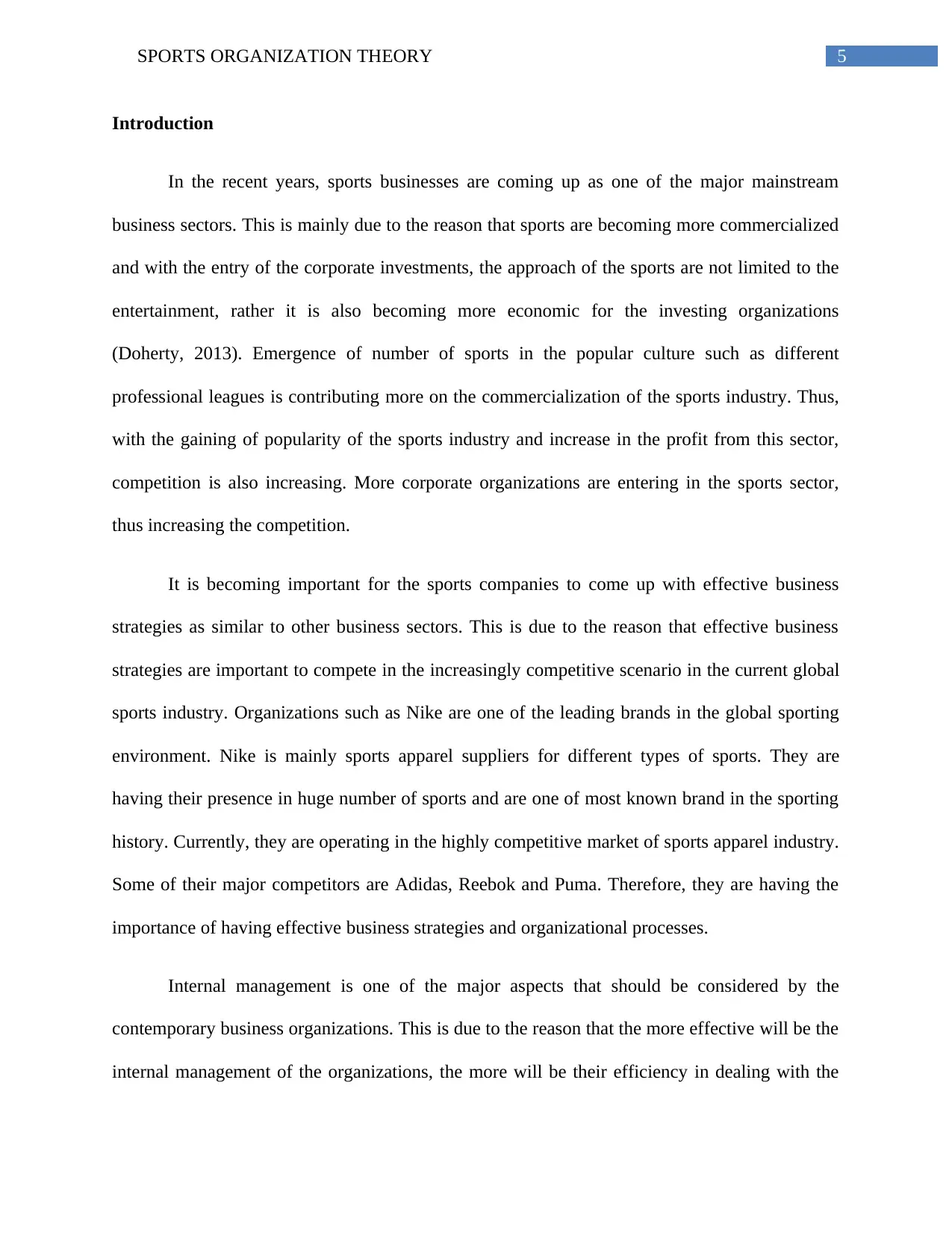
5SPORTS ORGANIZATION THEORY
Introduction
In the recent years, sports businesses are coming up as one of the major mainstream
business sectors. This is mainly due to the reason that sports are becoming more commercialized
and with the entry of the corporate investments, the approach of the sports are not limited to the
entertainment, rather it is also becoming more economic for the investing organizations
(Doherty, 2013). Emergence of number of sports in the popular culture such as different
professional leagues is contributing more on the commercialization of the sports industry. Thus,
with the gaining of popularity of the sports industry and increase in the profit from this sector,
competition is also increasing. More corporate organizations are entering in the sports sector,
thus increasing the competition.
It is becoming important for the sports companies to come up with effective business
strategies as similar to other business sectors. This is due to the reason that effective business
strategies are important to compete in the increasingly competitive scenario in the current global
sports industry. Organizations such as Nike are one of the leading brands in the global sporting
environment. Nike is mainly sports apparel suppliers for different types of sports. They are
having their presence in huge number of sports and are one of most known brand in the sporting
history. Currently, they are operating in the highly competitive market of sports apparel industry.
Some of their major competitors are Adidas, Reebok and Puma. Therefore, they are having the
importance of having effective business strategies and organizational processes.
Internal management is one of the major aspects that should be considered by the
contemporary business organizations. This is due to the reason that the more effective will be the
internal management of the organizations, the more will be their efficiency in dealing with the
Introduction
In the recent years, sports businesses are coming up as one of the major mainstream
business sectors. This is mainly due to the reason that sports are becoming more commercialized
and with the entry of the corporate investments, the approach of the sports are not limited to the
entertainment, rather it is also becoming more economic for the investing organizations
(Doherty, 2013). Emergence of number of sports in the popular culture such as different
professional leagues is contributing more on the commercialization of the sports industry. Thus,
with the gaining of popularity of the sports industry and increase in the profit from this sector,
competition is also increasing. More corporate organizations are entering in the sports sector,
thus increasing the competition.
It is becoming important for the sports companies to come up with effective business
strategies as similar to other business sectors. This is due to the reason that effective business
strategies are important to compete in the increasingly competitive scenario in the current global
sports industry. Organizations such as Nike are one of the leading brands in the global sporting
environment. Nike is mainly sports apparel suppliers for different types of sports. They are
having their presence in huge number of sports and are one of most known brand in the sporting
history. Currently, they are operating in the highly competitive market of sports apparel industry.
Some of their major competitors are Adidas, Reebok and Puma. Therefore, they are having the
importance of having effective business strategies and organizational processes.
Internal management is one of the major aspects that should be considered by the
contemporary business organizations. This is due to the reason that the more effective will be the
internal management of the organizations, the more will be their efficiency in dealing with the
⊘ This is a preview!⊘
Do you want full access?
Subscribe today to unlock all pages.

Trusted by 1+ million students worldwide
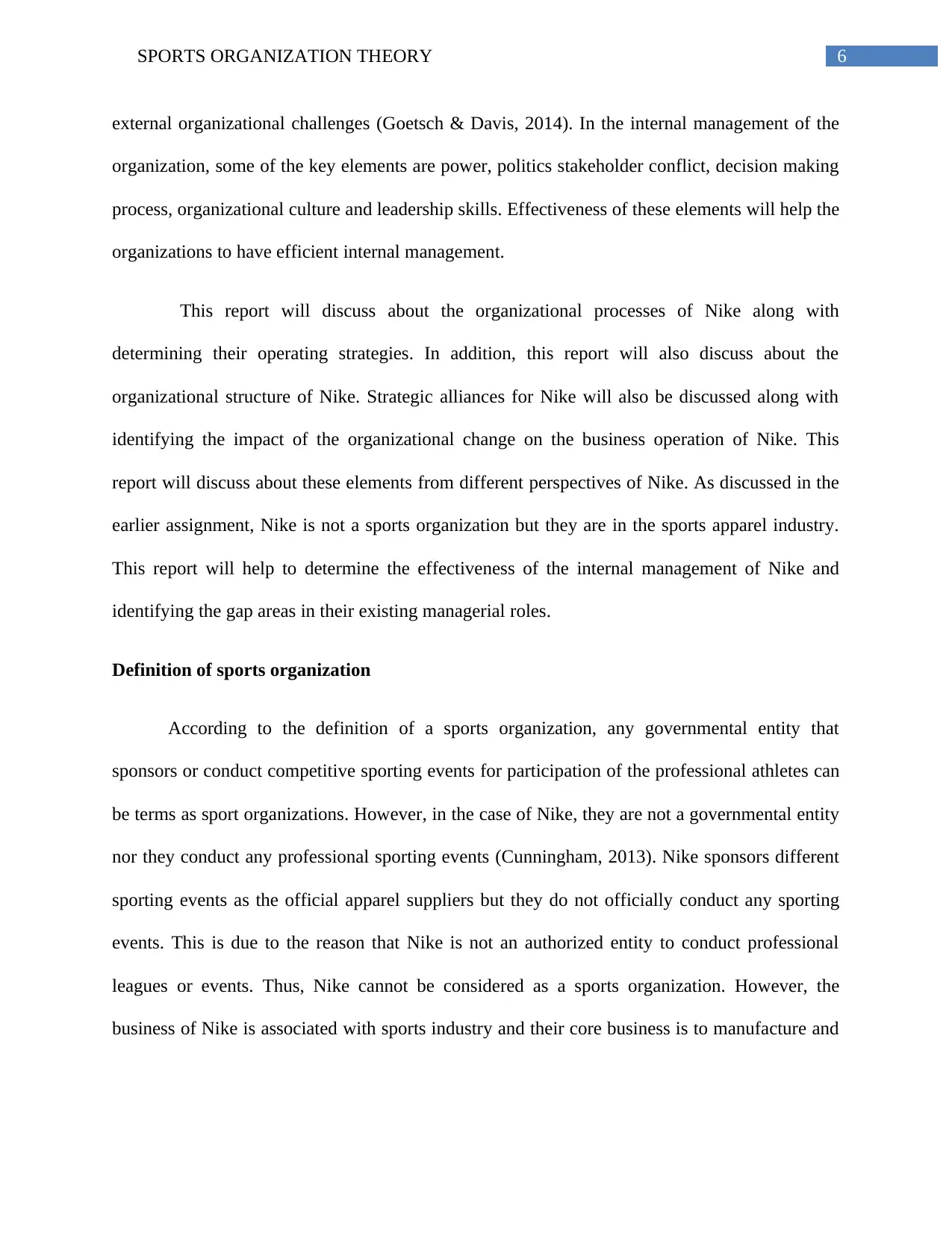
6SPORTS ORGANIZATION THEORY
external organizational challenges (Goetsch & Davis, 2014). In the internal management of the
organization, some of the key elements are power, politics stakeholder conflict, decision making
process, organizational culture and leadership skills. Effectiveness of these elements will help the
organizations to have efficient internal management.
This report will discuss about the organizational processes of Nike along with
determining their operating strategies. In addition, this report will also discuss about the
organizational structure of Nike. Strategic alliances for Nike will also be discussed along with
identifying the impact of the organizational change on the business operation of Nike. This
report will discuss about these elements from different perspectives of Nike. As discussed in the
earlier assignment, Nike is not a sports organization but they are in the sports apparel industry.
This report will help to determine the effectiveness of the internal management of Nike and
identifying the gap areas in their existing managerial roles.
Definition of sports organization
According to the definition of a sports organization, any governmental entity that
sponsors or conduct competitive sporting events for participation of the professional athletes can
be terms as sport organizations. However, in the case of Nike, they are not a governmental entity
nor they conduct any professional sporting events (Cunningham, 2013). Nike sponsors different
sporting events as the official apparel suppliers but they do not officially conduct any sporting
events. This is due to the reason that Nike is not an authorized entity to conduct professional
leagues or events. Thus, Nike cannot be considered as a sports organization. However, the
business of Nike is associated with sports industry and their core business is to manufacture and
external organizational challenges (Goetsch & Davis, 2014). In the internal management of the
organization, some of the key elements are power, politics stakeholder conflict, decision making
process, organizational culture and leadership skills. Effectiveness of these elements will help the
organizations to have efficient internal management.
This report will discuss about the organizational processes of Nike along with
determining their operating strategies. In addition, this report will also discuss about the
organizational structure of Nike. Strategic alliances for Nike will also be discussed along with
identifying the impact of the organizational change on the business operation of Nike. This
report will discuss about these elements from different perspectives of Nike. As discussed in the
earlier assignment, Nike is not a sports organization but they are in the sports apparel industry.
This report will help to determine the effectiveness of the internal management of Nike and
identifying the gap areas in their existing managerial roles.
Definition of sports organization
According to the definition of a sports organization, any governmental entity that
sponsors or conduct competitive sporting events for participation of the professional athletes can
be terms as sport organizations. However, in the case of Nike, they are not a governmental entity
nor they conduct any professional sporting events (Cunningham, 2013). Nike sponsors different
sporting events as the official apparel suppliers but they do not officially conduct any sporting
events. This is due to the reason that Nike is not an authorized entity to conduct professional
leagues or events. Thus, Nike cannot be considered as a sports organization. However, the
business of Nike is associated with sports industry and their core business is to manufacture and
Paraphrase This Document
Need a fresh take? Get an instant paraphrase of this document with our AI Paraphraser
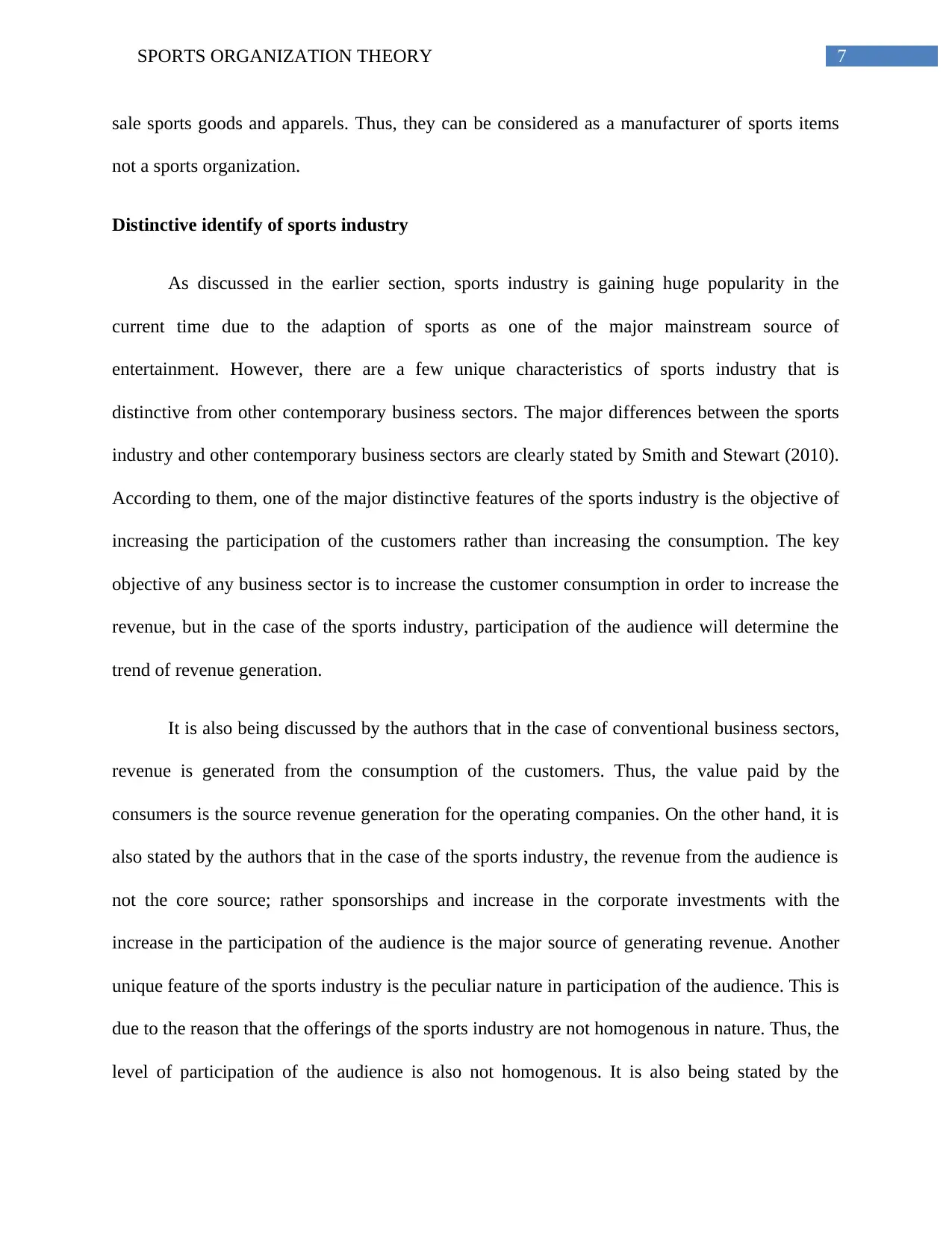
7SPORTS ORGANIZATION THEORY
sale sports goods and apparels. Thus, they can be considered as a manufacturer of sports items
not a sports organization.
Distinctive identify of sports industry
As discussed in the earlier section, sports industry is gaining huge popularity in the
current time due to the adaption of sports as one of the major mainstream source of
entertainment. However, there are a few unique characteristics of sports industry that is
distinctive from other contemporary business sectors. The major differences between the sports
industry and other contemporary business sectors are clearly stated by Smith and Stewart (2010).
According to them, one of the major distinctive features of the sports industry is the objective of
increasing the participation of the customers rather than increasing the consumption. The key
objective of any business sector is to increase the customer consumption in order to increase the
revenue, but in the case of the sports industry, participation of the audience will determine the
trend of revenue generation.
It is also being discussed by the authors that in the case of conventional business sectors,
revenue is generated from the consumption of the customers. Thus, the value paid by the
consumers is the source revenue generation for the operating companies. On the other hand, it is
also stated by the authors that in the case of the sports industry, the revenue from the audience is
not the core source; rather sponsorships and increase in the corporate investments with the
increase in the participation of the audience is the major source of generating revenue. Another
unique feature of the sports industry is the peculiar nature in participation of the audience. This is
due to the reason that the offerings of the sports industry are not homogenous in nature. Thus, the
level of participation of the audience is also not homogenous. It is also being stated by the
sale sports goods and apparels. Thus, they can be considered as a manufacturer of sports items
not a sports organization.
Distinctive identify of sports industry
As discussed in the earlier section, sports industry is gaining huge popularity in the
current time due to the adaption of sports as one of the major mainstream source of
entertainment. However, there are a few unique characteristics of sports industry that is
distinctive from other contemporary business sectors. The major differences between the sports
industry and other contemporary business sectors are clearly stated by Smith and Stewart (2010).
According to them, one of the major distinctive features of the sports industry is the objective of
increasing the participation of the customers rather than increasing the consumption. The key
objective of any business sector is to increase the customer consumption in order to increase the
revenue, but in the case of the sports industry, participation of the audience will determine the
trend of revenue generation.
It is also being discussed by the authors that in the case of conventional business sectors,
revenue is generated from the consumption of the customers. Thus, the value paid by the
consumers is the source revenue generation for the operating companies. On the other hand, it is
also stated by the authors that in the case of the sports industry, the revenue from the audience is
not the core source; rather sponsorships and increase in the corporate investments with the
increase in the participation of the audience is the major source of generating revenue. Another
unique feature of the sports industry is the peculiar nature in participation of the audience. This is
due to the reason that the offerings of the sports industry are not homogenous in nature. Thus, the
level of participation of the audience is also not homogenous. It is also being stated by the
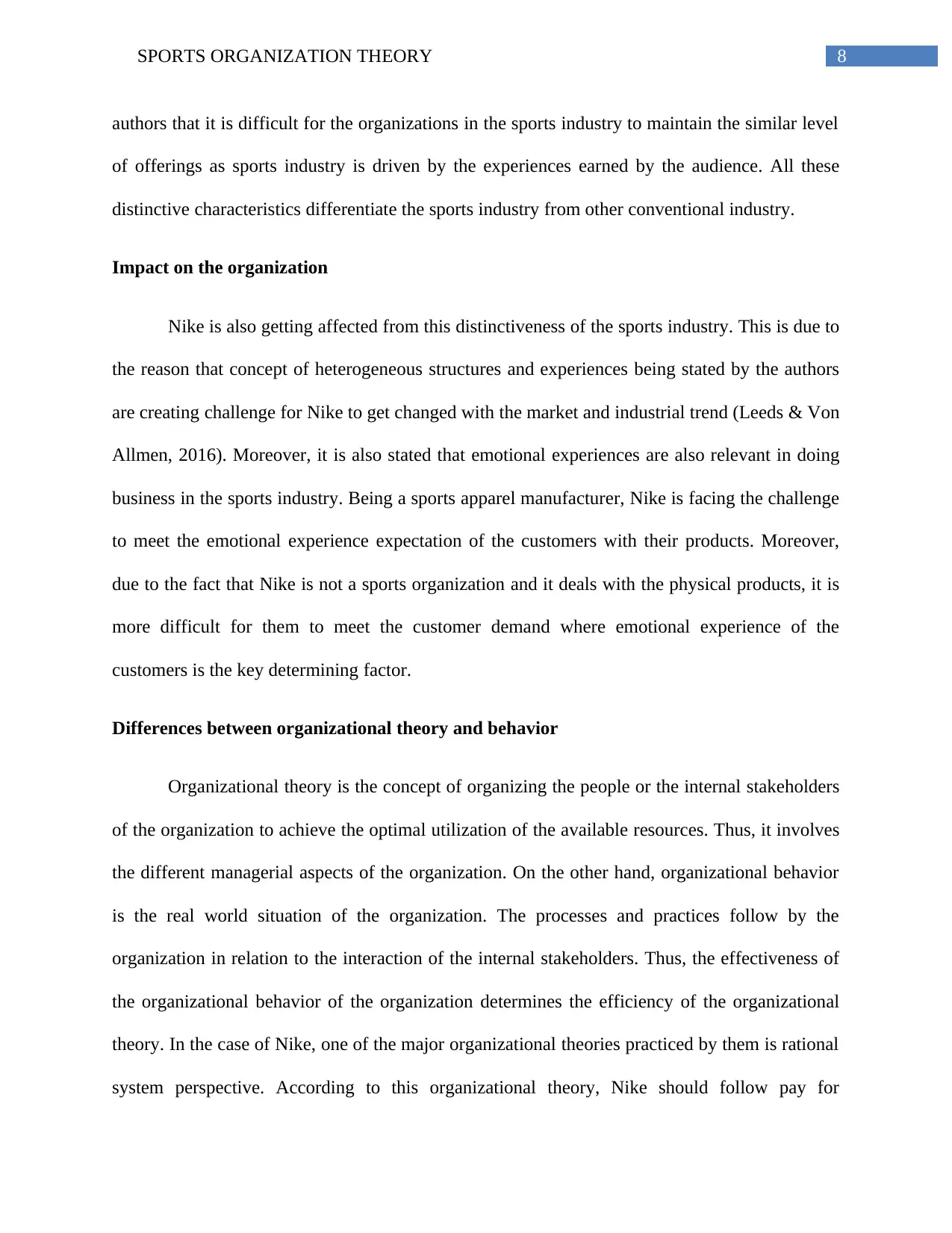
8SPORTS ORGANIZATION THEORY
authors that it is difficult for the organizations in the sports industry to maintain the similar level
of offerings as sports industry is driven by the experiences earned by the audience. All these
distinctive characteristics differentiate the sports industry from other conventional industry.
Impact on the organization
Nike is also getting affected from this distinctiveness of the sports industry. This is due to
the reason that concept of heterogeneous structures and experiences being stated by the authors
are creating challenge for Nike to get changed with the market and industrial trend (Leeds & Von
Allmen, 2016). Moreover, it is also stated that emotional experiences are also relevant in doing
business in the sports industry. Being a sports apparel manufacturer, Nike is facing the challenge
to meet the emotional experience expectation of the customers with their products. Moreover,
due to the fact that Nike is not a sports organization and it deals with the physical products, it is
more difficult for them to meet the customer demand where emotional experience of the
customers is the key determining factor.
Differences between organizational theory and behavior
Organizational theory is the concept of organizing the people or the internal stakeholders
of the organization to achieve the optimal utilization of the available resources. Thus, it involves
the different managerial aspects of the organization. On the other hand, organizational behavior
is the real world situation of the organization. The processes and practices follow by the
organization in relation to the interaction of the internal stakeholders. Thus, the effectiveness of
the organizational behavior of the organization determines the efficiency of the organizational
theory. In the case of Nike, one of the major organizational theories practiced by them is rational
system perspective. According to this organizational theory, Nike should follow pay for
authors that it is difficult for the organizations in the sports industry to maintain the similar level
of offerings as sports industry is driven by the experiences earned by the audience. All these
distinctive characteristics differentiate the sports industry from other conventional industry.
Impact on the organization
Nike is also getting affected from this distinctiveness of the sports industry. This is due to
the reason that concept of heterogeneous structures and experiences being stated by the authors
are creating challenge for Nike to get changed with the market and industrial trend (Leeds & Von
Allmen, 2016). Moreover, it is also stated that emotional experiences are also relevant in doing
business in the sports industry. Being a sports apparel manufacturer, Nike is facing the challenge
to meet the emotional experience expectation of the customers with their products. Moreover,
due to the fact that Nike is not a sports organization and it deals with the physical products, it is
more difficult for them to meet the customer demand where emotional experience of the
customers is the key determining factor.
Differences between organizational theory and behavior
Organizational theory is the concept of organizing the people or the internal stakeholders
of the organization to achieve the optimal utilization of the available resources. Thus, it involves
the different managerial aspects of the organization. On the other hand, organizational behavior
is the real world situation of the organization. The processes and practices follow by the
organization in relation to the interaction of the internal stakeholders. Thus, the effectiveness of
the organizational behavior of the organization determines the efficiency of the organizational
theory. In the case of Nike, one of the major organizational theories practiced by them is rational
system perspective. According to this organizational theory, Nike should follow pay for
⊘ This is a preview!⊘
Do you want full access?
Subscribe today to unlock all pages.

Trusted by 1+ million students worldwide
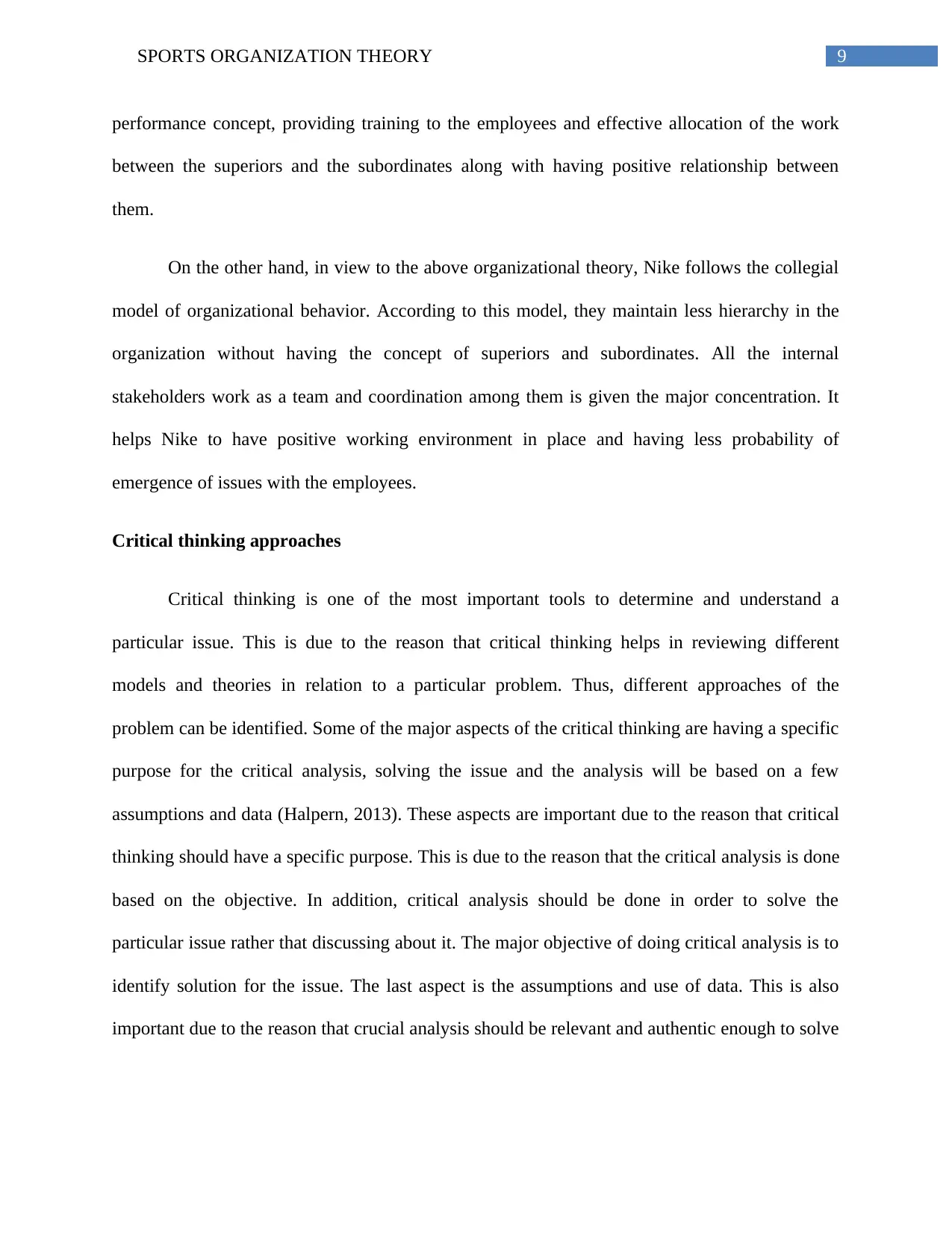
9SPORTS ORGANIZATION THEORY
performance concept, providing training to the employees and effective allocation of the work
between the superiors and the subordinates along with having positive relationship between
them.
On the other hand, in view to the above organizational theory, Nike follows the collegial
model of organizational behavior. According to this model, they maintain less hierarchy in the
organization without having the concept of superiors and subordinates. All the internal
stakeholders work as a team and coordination among them is given the major concentration. It
helps Nike to have positive working environment in place and having less probability of
emergence of issues with the employees.
Critical thinking approaches
Critical thinking is one of the most important tools to determine and understand a
particular issue. This is due to the reason that critical thinking helps in reviewing different
models and theories in relation to a particular problem. Thus, different approaches of the
problem can be identified. Some of the major aspects of the critical thinking are having a specific
purpose for the critical analysis, solving the issue and the analysis will be based on a few
assumptions and data (Halpern, 2013). These aspects are important due to the reason that critical
thinking should have a specific purpose. This is due to the reason that the critical analysis is done
based on the objective. In addition, critical analysis should be done in order to solve the
particular issue rather that discussing about it. The major objective of doing critical analysis is to
identify solution for the issue. The last aspect is the assumptions and use of data. This is also
important due to the reason that crucial analysis should be relevant and authentic enough to solve
performance concept, providing training to the employees and effective allocation of the work
between the superiors and the subordinates along with having positive relationship between
them.
On the other hand, in view to the above organizational theory, Nike follows the collegial
model of organizational behavior. According to this model, they maintain less hierarchy in the
organization without having the concept of superiors and subordinates. All the internal
stakeholders work as a team and coordination among them is given the major concentration. It
helps Nike to have positive working environment in place and having less probability of
emergence of issues with the employees.
Critical thinking approaches
Critical thinking is one of the most important tools to determine and understand a
particular issue. This is due to the reason that critical thinking helps in reviewing different
models and theories in relation to a particular problem. Thus, different approaches of the
problem can be identified. Some of the major aspects of the critical thinking are having a specific
purpose for the critical analysis, solving the issue and the analysis will be based on a few
assumptions and data (Halpern, 2013). These aspects are important due to the reason that critical
thinking should have a specific purpose. This is due to the reason that the critical analysis is done
based on the objective. In addition, critical analysis should be done in order to solve the
particular issue rather that discussing about it. The major objective of doing critical analysis is to
identify solution for the issue. The last aspect is the assumptions and use of data. This is also
important due to the reason that crucial analysis should be relevant and authentic enough to solve
Paraphrase This Document
Need a fresh take? Get an instant paraphrase of this document with our AI Paraphraser
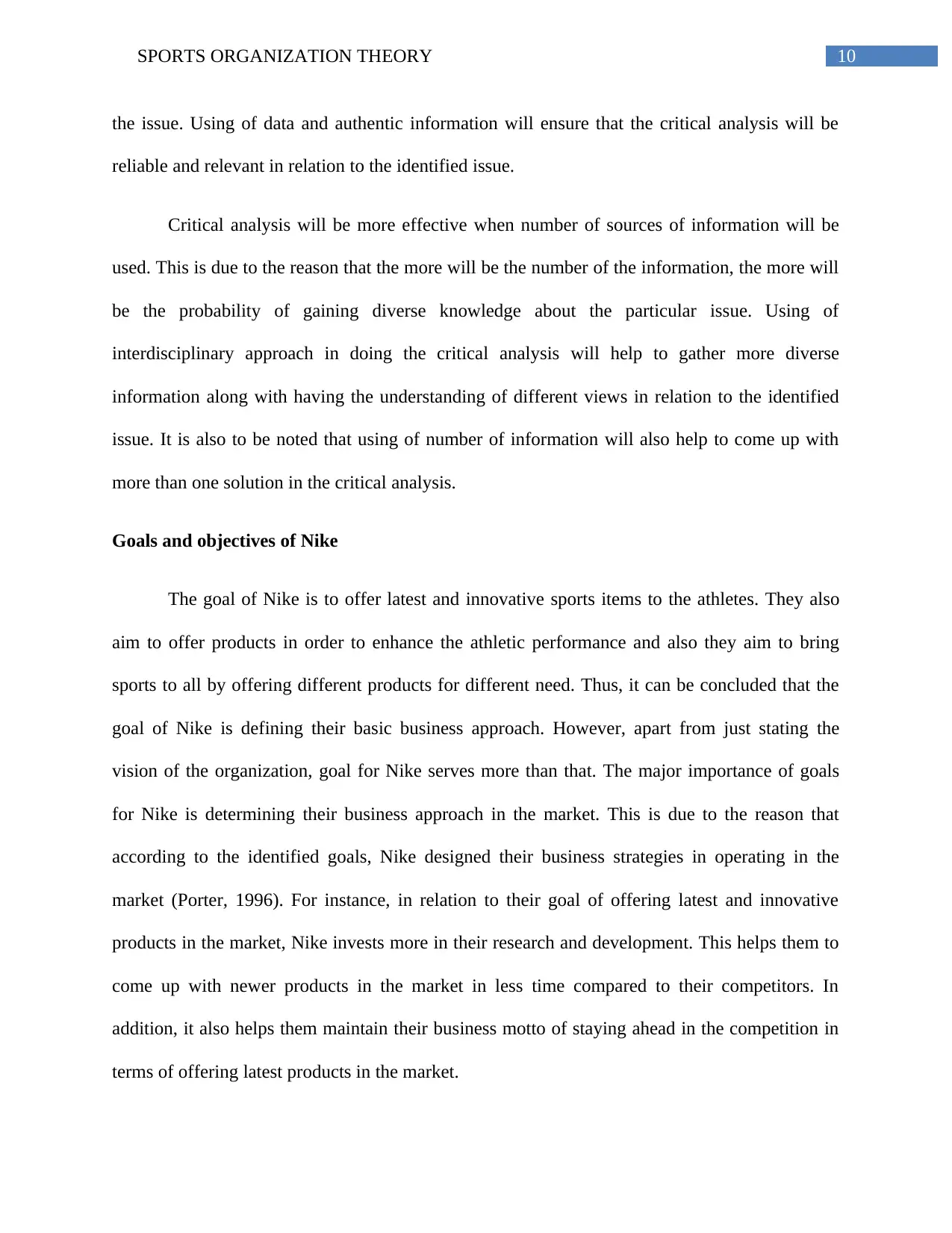
10SPORTS ORGANIZATION THEORY
the issue. Using of data and authentic information will ensure that the critical analysis will be
reliable and relevant in relation to the identified issue.
Critical analysis will be more effective when number of sources of information will be
used. This is due to the reason that the more will be the number of the information, the more will
be the probability of gaining diverse knowledge about the particular issue. Using of
interdisciplinary approach in doing the critical analysis will help to gather more diverse
information along with having the understanding of different views in relation to the identified
issue. It is also to be noted that using of number of information will also help to come up with
more than one solution in the critical analysis.
Goals and objectives of Nike
The goal of Nike is to offer latest and innovative sports items to the athletes. They also
aim to offer products in order to enhance the athletic performance and also they aim to bring
sports to all by offering different products for different need. Thus, it can be concluded that the
goal of Nike is defining their basic business approach. However, apart from just stating the
vision of the organization, goal for Nike serves more than that. The major importance of goals
for Nike is determining their business approach in the market. This is due to the reason that
according to the identified goals, Nike designed their business strategies in operating in the
market (Porter, 1996). For instance, in relation to their goal of offering latest and innovative
products in the market, Nike invests more in their research and development. This helps them to
come up with newer products in the market in less time compared to their competitors. In
addition, it also helps them maintain their business motto of staying ahead in the competition in
terms of offering latest products in the market.
the issue. Using of data and authentic information will ensure that the critical analysis will be
reliable and relevant in relation to the identified issue.
Critical analysis will be more effective when number of sources of information will be
used. This is due to the reason that the more will be the number of the information, the more will
be the probability of gaining diverse knowledge about the particular issue. Using of
interdisciplinary approach in doing the critical analysis will help to gather more diverse
information along with having the understanding of different views in relation to the identified
issue. It is also to be noted that using of number of information will also help to come up with
more than one solution in the critical analysis.
Goals and objectives of Nike
The goal of Nike is to offer latest and innovative sports items to the athletes. They also
aim to offer products in order to enhance the athletic performance and also they aim to bring
sports to all by offering different products for different need. Thus, it can be concluded that the
goal of Nike is defining their basic business approach. However, apart from just stating the
vision of the organization, goal for Nike serves more than that. The major importance of goals
for Nike is determining their business approach in the market. This is due to the reason that
according to the identified goals, Nike designed their business strategies in operating in the
market (Porter, 1996). For instance, in relation to their goal of offering latest and innovative
products in the market, Nike invests more in their research and development. This helps them to
come up with newer products in the market in less time compared to their competitors. In
addition, it also helps them maintain their business motto of staying ahead in the competition in
terms of offering latest products in the market.
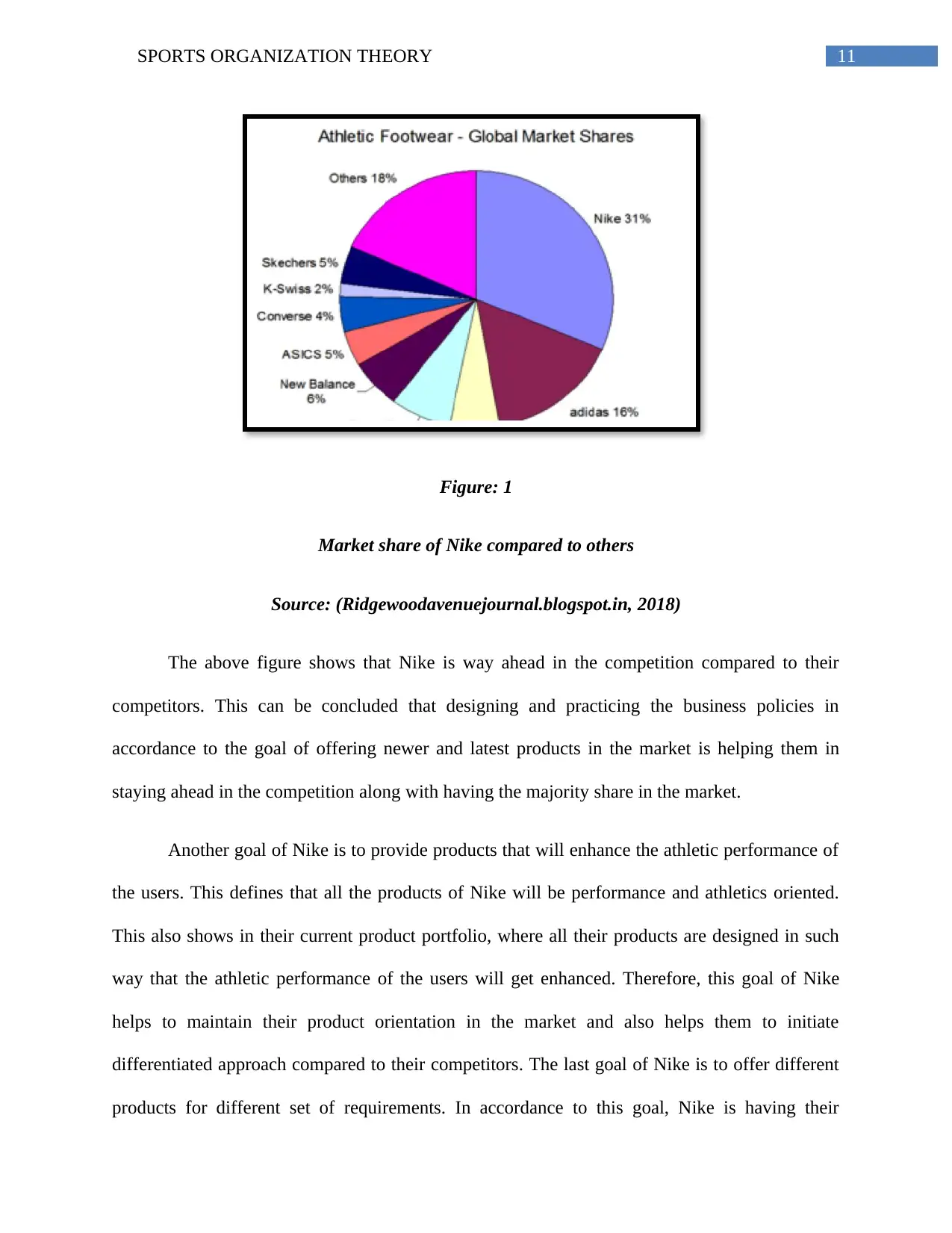
11SPORTS ORGANIZATION THEORY
Figure: 1
Market share of Nike compared to others
Source: (Ridgewoodavenuejournal.blogspot.in, 2018)
The above figure shows that Nike is way ahead in the competition compared to their
competitors. This can be concluded that designing and practicing the business policies in
accordance to the goal of offering newer and latest products in the market is helping them in
staying ahead in the competition along with having the majority share in the market.
Another goal of Nike is to provide products that will enhance the athletic performance of
the users. This defines that all the products of Nike will be performance and athletics oriented.
This also shows in their current product portfolio, where all their products are designed in such
way that the athletic performance of the users will get enhanced. Therefore, this goal of Nike
helps to maintain their product orientation in the market and also helps them to initiate
differentiated approach compared to their competitors. The last goal of Nike is to offer different
products for different set of requirements. In accordance to this goal, Nike is having their
Figure: 1
Market share of Nike compared to others
Source: (Ridgewoodavenuejournal.blogspot.in, 2018)
The above figure shows that Nike is way ahead in the competition compared to their
competitors. This can be concluded that designing and practicing the business policies in
accordance to the goal of offering newer and latest products in the market is helping them in
staying ahead in the competition along with having the majority share in the market.
Another goal of Nike is to provide products that will enhance the athletic performance of
the users. This defines that all the products of Nike will be performance and athletics oriented.
This also shows in their current product portfolio, where all their products are designed in such
way that the athletic performance of the users will get enhanced. Therefore, this goal of Nike
helps to maintain their product orientation in the market and also helps them to initiate
differentiated approach compared to their competitors. The last goal of Nike is to offer different
products for different set of requirements. In accordance to this goal, Nike is having their
⊘ This is a preview!⊘
Do you want full access?
Subscribe today to unlock all pages.

Trusted by 1+ million students worldwide
1 out of 37
Related Documents
Your All-in-One AI-Powered Toolkit for Academic Success.
+13062052269
info@desklib.com
Available 24*7 on WhatsApp / Email
![[object Object]](/_next/static/media/star-bottom.7253800d.svg)
Unlock your academic potential
Copyright © 2020–2025 A2Z Services. All Rights Reserved. Developed and managed by ZUCOL.





